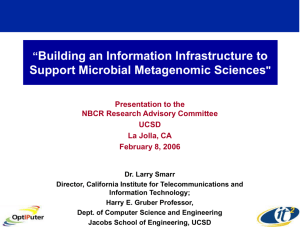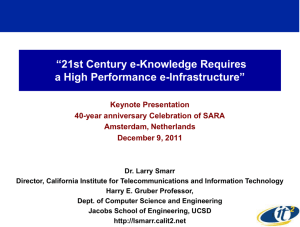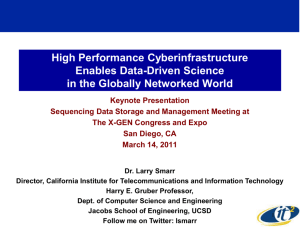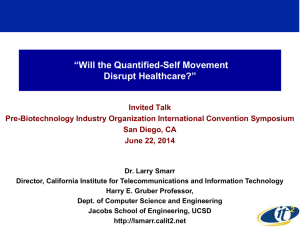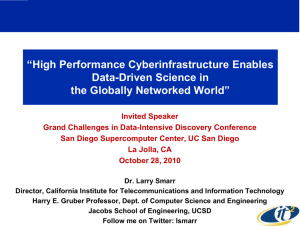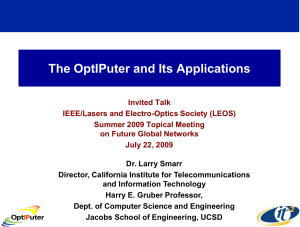PPT - Larry Smarr - California Institute for Telecommunications and
advertisement
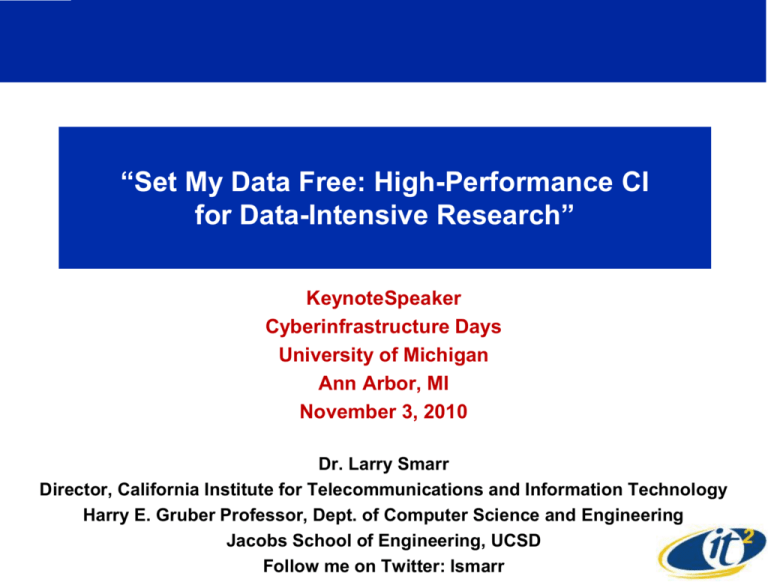
“Set My Data Free: High-Performance CI for Data-Intensive Research” KeynoteSpeaker Cyberinfrastructure Days University of Michigan Ann Arbor, MI November 3, 2010 Dr. Larry Smarr Director, California Institute for Telecommunications and Information Technology Harry E. Gruber Professor, Dept. of Computer Science and Engineering Jacobs School of Engineering, UCSD Follow me on Twitter: lsmarr Abstract As the need for large datasets and high-volume transfer grows, the shared Internet is becoming a bottleneck for cutting-edge research in universities. What are needed instead are largebandwidth "data freeways." In this talk, I will describe some of the state-of-the-art uses of high-performance CI and how universities can evolve to support free movement of large datasets. The Data-Intensive Discovery Era Requires High Performance Cyberinfrastructure • Growth of Digital Data is Exponential – “Data Tsunami” • Driven by Advances in Digital Detectors, Computing, Networking, & Storage Technologies • Shared Internet Optimized for Megabyte-Size Objects • Need Dedicated Photonic Cyberinfrastructure for Gigabyte/Terabyte Data Objects • Finding Patterns in the Data is the New Imperative – – – – Data-Driven Applications Data Mining Visual Analytics Data Analysis Workflows Source: SDSC Large Data Challenge: Average Throughput to End User on Shared Internet is 10-100 Mbps Tested October 2010 Transferring 1 TB: --10 Mbps = 10 Days --10 Gbps = 15 Minutes http://ensight.eos.nasa.gov/Missions/icesat/index.shtml The Large Hadron Collider Uses a Global Fiber Infrastructure To Connect Its Users • The grid relies on optical fiber networks to distribute data from CERN to 11 major computer centers in Europe, North America, and Asia • The grid is capable of routinely processing 250,000 jobs a day • The data flow will be ~6 Gigabits/sec or 15 million gigabytes a year for 10 to 15 years Next Great Planetary Instrument: The Square Kilometer Array Requires Dedicated Fiber www.skatelescope.org Transfers Of 1 TByte Images World-wide Will Be Needed Every Minute! Currently Competing Between Australia and S. Africa GRAND CHALLENGES IN DATA-INTENSIVE SCIENCES OCTOBER 26-28, 2010 SAN DIEGO SUPERCOMPUTER CENTER , UC SAN DIEGO Confirmed conference topics and speakers : Needs and Opportunities in Observational Astronomy - Alex Szalay, JHU Transient Sky Surveys – Peter Nugent, LBNL Large Data-Intensive Graph Problems – John Gilbert, UCSB Algorithms for Massive Data Sets – Michael Mahoney, Stanford U. Needs and Opportunities in Seismic Modeling and Earthquake Preparedness Tom Jordan, USC Needs and Opportunities in Fluid Dynamics Modeling and Flow Field Data Analysis – Parviz Moin, Stanford U. Needs and Emerging Opportunities in Neuroscience – Mark Ellisman, UCSD Data-Driven Science in the Globally Networked World – Larry Smarr, UCSD Petascale High Performance Computing Generates TB Datasets to Analyze Growth of Turbulence Data Over Three Decades (Assuming Double Precision and Collocated Points) Year Authors Simulation Points Size 1972 Orszag & Patterson Isotropic Turbulence 323 1 MB 1987 Kim, Moin & Moser Plane Channel Flow 192x160x128 120 MB 1988 Spalart Turbulent Boundary Layer 432x80x320 340 MB 1994 Le & Moin Backward-Facing Step 768x64x192 288 MB 2000 Freund, Lele & Moin Compressible Turbulent Jet 640x270x128 845 MB 2003 Earth Simulator Isotropic Turbulence 40963 0.8 TB* 2006 Hoyas & Jiménez Plane Channel Flow 6144x633x460 8 550 GB 2008 Wu & Moin Turbulent Pipe Flow 256x5122 2.1 GB 2009 Larsson & Lele Isotropic Shock-Turbulence 1080x3842 6.1 GB 2010 Wu & Moin Turbulent Boundary Layer 8192x500x256 40 GB Turbulent Boundary Layer: One-Periodic Direction 100x Larger Data Sets in 20 Years Source: Parviz Moin, Stanford CyberShake 1.0 Hazard Model Need to Analyze Terabytes of Computed Data • CyberShake 1.0 Computation - 440,000 Simulations per Site - 5.5 Million CPU hrs (50-Day Run on Ranger Using 4,400 cores) - 189 Million Jobs - 165 TB of Total Output Data - 10.6 TB of Stored Data - 2.1 TB of Archived Data Source: Thomas H. Jordan, USC, Director, Southern California Earthquake Center CyberShake seismogram CyberShake Hazard Map PoE = 2% in 50 yrs LA region Large-Scale PetaApps Climate Change Run Generates Terabyte Per Day of Computed Data • 155 Year Control Run – – – – 0.1° Ocean model [ 3600 x 2400 x 42 ] 0.1° Sea-ice model [3600 x 2400 x 20 ] 0.5° Atmosphere [576 x 384 x 26 ] 0.5° Land [576 x 384] 100x Current Production • Statistics – – – – 4x current production ~18M CPU Hours 5844 Cores for 4-5 Months ~100 TB of Data Generated 0.5 to 1 TB per Wall Clock Day Generated 10 Source: John M. Dennis, Matthew Woitaszek, UCAR The Required Components of High Performance Cyberinfrastructure • • • • • High Performance Optical Networks Scalable Visualization and Analysis Multi-Site Collaborative Systems End-to-End Wide Area CI Data-Intensive Campus Research CI Australia—The Broadband Nation: Universal Coverage with Fiber, Wireless, Satellite • Connect 93% of All Australian Premises with Fiber – 100 Mbps to Start, Upgrading to Gigabit • 7% with Next Gen Wireless and Satellite – 12 Mbps to Start • Provide Equal Wholesale Access to Retailers – Providing Advanced Digital Services to the Nation – Driven by Consumer Internet, Telephone, Video – “Triple Play”, eHealth, eCommerce… “NBN is Australia’s largest nation building project in our history.” - Minister Stephen Conroy www.nbnco.com.au Globally Fiber to the Premise is Growing Rapidly, Mostly in Asia FTTP Connections Growing at ~30%/year If Couch Potatoes Deserve a Gigabit Fiber, Why Not University Data-Intensive Researchers? 130 Million Households with FTTH in 2013 Source: Heavy Reading (www.heavyreading.com), the market research division of Light Reading (www.lightreading.com). The Global Lambda Integrated Facility-Creating a Planetary-Scale High Bandwidth Collaboratory Research Innovation Labs Linked by 10G GLIF www.glif.is Created in Reykjavik, Iceland 2003 Visualization courtesy of Bob Patterson, NCSA. The OptIPuter Project: Creating High Resolution Portals Over Dedicated Optical Channels to Global Science Data Scalable Adaptive Graphics Environment (SAGE) Picture Source: Mark Ellisman, David Lee, Jason Leigh Calit2 (UCSD, UCI), SDSC, and UIC Leads—Larry Smarr PI Univ. Partners: NCSA, USC, SDSU, NW, TA&M, UvA, SARA, KISTI, AIST Industry: IBM, Sun, Telcordia, Chiaro, Calient, Glimmerglass, Lucent Nearly Seamless AESOP OptIPortal 46” NEC Ultra-Narrow Bezel 720p LCD Monitors Source: Tom DeFanti, Calit2@UCSD; 3D Stereo Head Tracked OptIPortal: NexCAVE Array of JVC HDTV 3D LCD Screens KAUST NexCAVE = 22.5MPixels www.calit2.net/newsroom/article.php?id=1584 Source: Tom DeFanti, Calit2@UCSD High Definition Video Connected OptIPortals: Virtual Working Spaces for Data Intensive Research NASA Supports Two Virtual Institutes LifeSize HD Calit2@UCSD 10Gbps Link to NASA Ames Lunar Science Institute, Mountain View, CA Source: Falko Kuester, Kai Doerr Calit2; Michael Sims, Larry Edwards, Estelle Dodson NASA U Michigan Virtual Space Interaction Testbed (VISIT) Instrumenting OptIPortals for Social Science Research • Using Cameras Embedded in the Seams of Tiled Displays and Computer Vision Techniques, we can Understand how People Interact with OptIPortals – Classify Attention, Expression, Gaze – Initial Implementation Based on Attention Interaction Design Toolkit (J. Lee, MIT) • Close to Producing Usable Eye/Nose Tracking Data using OpenCV Leading U.S. Researchers on the Social Aspects of Collaboration Source: Erik Hofer, UMich, School of Information EVL’s SAGE OptIPortal VisualCasting Multi-Site OptIPuter Collaboratory CENIC CalREN-XD Workshop Sept. 15, 2008 Total Aggregate VisualCasting Bandwidth for Nov. 18, 2008 EVL-UI Chicago Sustained 10,000-20,000 Mbps! At Supercomputing 2008 Austin, Texas November, 2008 SC08 Bandwidth Challenge Entry Streaming 4k Remote: On site: SARA (Amsterdam) GIST / KISTI (Korea) Osaka Univ. (Japan) U Michigan U of Michigan UIC/EVL U of Queensland Russian Academy of Science Masaryk Univ. (CZ) Requires 10 Gbps Lightpath to Each Site Source: Jason Leigh, Luc Renambot, EVL, UI Chicago Exploring Cosmology With Supercomputers, Supernetworks, and Supervisualization Source: Mike Norman, SDSC Intergalactic Medium on 2 GLyr Scale • 40963 Particle/Cell Hydrodynamic Cosmology Simulation • NICS Kraken (XT5) – 16,384 cores • Output Science: Norman, Harkness,Paschos SDSC Visualization: Insley, ANL; Wagner SDSC • – 148 TB Movie Output (0.25 TB/file) – 80 TB Diagnostic Dumps (8 TB/file) ANL * Calit2 * LBNL * NICS * ORNL * SDSC Project StarGate Goals: Combining Supercomputers and Supernetworks • Create an “End-to-End” 10Gbps Workflow • Explore Use of OptIPortals as Petascale Supercomputer “Scalable Workstations” OptIPortal@SDSC • Exploit Dynamic 10Gbps Circuits on ESnet • Connect Hardware Resources at ORNL, ANL, SDSC • Show that Data Need Not be Trapped by the Network “Event Horizon” Rick Wagner Source: Michael Norman, SDSC, UCSD • ANL * Calit2 * LBNL * NICS * ORNL * SDSC Mike Norman Using Supernetworks to Couple End User’s OptIPortal to Remote Supercomputers and Visualization Servers Source: Mike Norman, Rick Wagner, SDSC Argonne NL DOE Eureka 100 Dual Quad Core Xeon Servers 200 NVIDIA Quadro FX GPUs in 50 Quadro Plex S4 1U enclosures 3.2 TB RAM rendering ESnet SDSC 10 Gb/s fiber optic network visualization Calit2/SDSC OptIPortal1 20 30” (2560 x 1600 pixel) LCD panels 10 NVIDIA Quadro FX 4600 graphics cards > 80 megapixels 10 Gb/s network throughout NSF TeraGrid Kraken Cray XT5 8,256 Compute Nodes 99,072 Compute Cores 129 TB RAM simulation *ANL * Calit2 * LBNL * NICS * ORNL * SDSC NICS ORNL National-Scale Interactive Remote Rendering of Large Datasets Over 10Gbps Fiber Network SDSC ESnet ALCF Science Data Network (SDN) > 10 Gb/s Fiber Optic Network Dynamic VLANs Configured Using OSCARS Visualization OptIPortal (40M pixels LCDs) 10 NVIDIA FX 4600 Cards 10 Gb/s Network Throughout Rendering Eureka 100 Dual Quad Core Xeon Servers 200 NVIDIA FX GPUs 3.2 TB RAM Interactive Remote Rendering Real-Time Volume Rendering Streamed from ANL to SDSC Last Year Last Week High-Resolution (4K+, 15+ FPS)—But: • Command-Line Driven • Fixed Color Maps, Transfer Functions • Slow Exploration of Data Now Driven by a Simple Web GUI •Rotate, Pan, Zoom •GUI Works from Most Browsers • Manipulate Colors and Opacity • Fast Renderer Response Time Source: Rick Wagner, SDSC NSF’s Ocean Observatory Initiative Has the Largest Funded NSF CI Grant OOI CI Grant: 30-40 Software Engineers Housed at Calit2@UCSD Source: Matthew Arrott, Calit2 Program Manager for OOI CI OOI CI is Built OOI on CI Dedicated Optical Physical Infrastructure Network Implementation Using Clouds Source: John Orcutt, Matthew Arrott, SIO/Calit2 California and Washington Universities Are Testing a 10Gbps Connected Commercial Data Cloud • Amazon Experiment for Big Data – Only Available Through CENIC & Pacific NW GigaPOP – Private 10Gbps Peering Paths – Includes Amazon EC2 Computing & S3 Storage Services • Early Experiments Underway – Robert Grossman, Open Cloud Consortium – Phil Papadopoulos, Calit2/SDSC Rocks Open Cloud OptIPuter Testbed--Manage and Compute Large Datasets Over 10Gbps Lambdas CENIC • • • • • 9 Racks 500 Nodes 1000+ Cores 10+ Gb/s Now Upgrading Portions to 100 Gb/s in 2010/2011 NLR C-Wave MREN Dragon Open Source SW Hadoop Sector/Sphere Nebula Thrift, GPB Eucalyptus Benchmarks 28 Source: Robert Grossman, UChicago Terasort on Open Cloud Testbed Sustains >5 Gbps--Only 5% Distance Penalty! Sorting 10 Billion Records (1.2 TB) at 4 Sites (120 Nodes) Source: Robert Grossman, UChicago Hybrid Cloud Computing with modENCODE Data • Computations in Bionimbus Can Span the Community Cloud & the Amazon Public Cloud to Form a Hybrid Cloud • Sector was used to Support the Data Transfer between Two Virtual Machines – One VM was at UIC and One VM was an Amazon EC2 Instance • Graph Illustrates How the Throughput between Two Virtual Machines in a Wide Area Cloud Depends upon the File Size Biological data (Bionimbus) Source: Robert Grossman, UChicago Ocean Modeling HPC In the Cloud: Tropical Pacific SST (2 Month Ave 2002) MIT GCM 1/3 Degree Horizontal Resolution, 51 Levels, Forced by NCEP2. Grid is 564x168x51, Model State is T,S,U,V,W and Sea Surface Height Run on EC2 HPC Instance. In Collaboration with OOI CI/Calit2 Source: B. Cornuelle, N. Martinez, C.Papadopoulos COMPAS, SIO Using Condor and Amazon EC2 on Adaptive Poisson-Boltzmann Solver (APBS) • APBS Rocks Roll (NBCR) + EC2 Roll + Condor Roll = Amazon VM • Cluster extension into Amazon using Condor Local Running in Amazon Cloud Cluster EC2 Cloud NBCR VM NBCR VM NBCR VM APBS + EC2 + Condor Source: Phil Papadopoulos, SDSC/Calit2 “Blueprint for the Digital University”--Report of the UCSD Research Cyberinfrastructure Design Team • Focus on Data-Intensive Cyberinfrastructure April 2009 No Data Bottlenecks --Design for Gigabit/s Data Flows http://research.ucsd.edu/documents/rcidt/RCIDTReportFinal2009.pdf What do Campuses Need to Build to Utilize CENIC’s Three Layer Network? ~ $14M Invested in Upgrade Now Campuses Need to Upgrade! Source: Jim Dolgonas, CENIC Current UCSD Optical Core: Bridging End-Users to CENIC L1, L2, L3 Services To 10GigE cluster node interfaces ..... To cluster nodes ..... Quartzite Communications Core Year 3 Enpoints: Wavelength Quartzite Selective >= 60 endpoints at 10 GigE Core Switch >= 32 Packet switched Lucent >= 32 Switched wavelengths >= 300 Connected endpoints To 10GigE cluster node interfaces and other switches Glimmerglass To cluster nodes ..... Production OOO Switch GigE Switch with Dual 10GigE Upliks To cluster nodes ... ..... 32 10GigE Approximately 0.5 TBit/s Arrive at the “Optical” Force10 Center of Campus. Switching is a Hybrid of: Packet Switch To other Packet, nodes Lambda, Circuit -OOO and Packet Switches GigE Switch with Dual 10GigE Upliks GigE 10GigE 4 GigE 4 pair fiber Juniper T320 Source: Phil Papadopoulos, SDSC/Calit2 (Quartzite PI, OptIPuter co-PI) Quartzite Network MRI #CNS-0421555; OptIPuter #ANI-0225642 GigE Switch with Dual 10GigE Upliks CalREN-HPR Research Cloud Campus Research Cloud UCSD Campus Investment in Fiber Enables Consolidation of Energy Efficient Computing & Storage WAN 10Gb: CENIC, NLR, I2 N x 10Gb Gordon – HPD System Cluster Condo Triton – Petascale Data Analysis DataOasis (Central) Storage Scientific Instruments Digital Data Collections Campus Lab Cluster Source: Philip Papadopoulos, SDSC/Calit2 OptIPortal Tile Display Wall The GreenLight Project: Instrumenting the Energy Cost of Computational Science • Focus on 5 Communities with At-Scale Computing Needs: – – – – – Metagenomics Ocean Observing Microscopy Bioinformatics Digital Media • Measure, Monitor, & Web Publish Real-Time Sensor Outputs – Via Service-oriented Architectures – Allow Researchers Anywhere To Study Computing Energy Cost – Enable Scientists To Explore Tactics For Maximizing Work/Watt • Develop Middleware that Automates Optimal Choice of Compute/RAM Power Strategies for Desired Greenness • Partnering With Minority-Serving Institutions Cyberinfrastructure Empowerment Coalition Source: Tom DeFanti, Calit2; GreenLight PI UCSD Biomed Centers Drive High Performance CI National Resource for Network Biology iDASH: Integrating Data for Analysis, Anonymization, and Sharing Calit2 Microbial Metagenomics ClusterNext Generation Optically Linked Science Data Server Source: Phil Papadopoulos, SDSC, Calit2 512 Processors ~5 Teraflops ~ 200 Terabytes Storage Several Large Users at Univ. Michigan 4000 Users From 90 Countries 1GbE and 10GbE Switched / Routed Core ~200TB Sun X4500 Storage 10GbE Calit2 CAMERA Automatic Overflows into SDSC Triton @ SDSC Triton Resource @ CALIT2 Transparently Sends Jobs to Submit Portal on Triton CAMERA Managed Job Submit Portal (VM) 10Gbps CAMERA DATA Direct Mount == No Data Staging Rapid Evolution of 10GbE Port Prices Makes Campus-Scale 10Gbps CI Affordable • Port Pricing is Falling • Density is Rising – Dramatically • Cost of 10GbE Approaching Cluster HPC Interconnects $80K/port Chiaro (60 Max) $ 5K Force 10 (40 max) ~$1000 (300+ Max) $ 500 Arista 48 ports 2005 2007 2009 Source: Philip Papadopoulos, SDSC/Calit2 $ 400 Arista 48 ports 2010 10G Switched Data Analysis Resource: SDSC’s Data Oasis RCN OptIPuter Colo CalRe n 32 Triton 20 24 32 Trestles 2 12 40 Existing Storage Oasis Procurement (RFP) Dash Gordon 8 100 • Phase0: > 8GB/s sustained, today • RFP for Phase1: > 40 GB/sec for Lustre • Nodes must be able to function as Lustre OSS (Linux) or NFS (Solaris) • Connectivity to Network is 2 x 10GbE/Node • Likely Reserve dollars for inexpensive replica servers Source: Philip Papadopoulos, SDSC/Calit2 1500 – 2000 TB > 40 GB/s NSF Funds a Data-Intensive Track 2 Supercomputer: SDSC’s Gordon-Coming Summer 2011 • Data-Intensive Supercomputer Based on SSD Flash Memory and Virtual Shared Memory SW – Emphasizes MEM and IOPS over FLOPS – Supernode has Virtual Shared Memory: – 2 TB RAM Aggregate – 8 TB SSD Aggregate – Total Machine = 32 Supernodes – 4 PB Disk Parallel File System >100 GB/s I/O • System Designed to Accelerate Access to Massive Data Bases being Generated in all Fields of Science, Engineering, Medicine, and Social Science Source: Mike Norman, Allan Snavely SDSC Academic Research “OptIPlatform” Cyberinfrastructure: A 10Gbps “End-to-End” Lightpath Cloud HD/4k Telepresence Instruments HPC End User OptIPortal 10G Lightpaths National LambdaRail Campus Optical Switch Data Repositories & Clusters HD/4k Video Cams HD/4k Video Images You Can Download This Presentation at lsmarr.calit2.net
